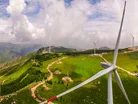China Cements Clean Energy Manufacturing Powerhouse Status

China stands as a towering force in the clean energy revolution, shaping supply chains and driving innovation in renewable technologies.
With the urgency of climate change pushing nations to rethink energy strategies, China’s investments, manufacturing expertise and policy support have positioned it as a central player in the clean energy sector.
The country consistently leads the global charge in clean energy investment, funnelling vast sums into renewable energy projects.
In 2022, it poured an astounding US$546bn into initiatives spanning solar and wind power, electric vehicles (EVs) and battery production.
This accounts for nearly half the world's total low-carbon spending, far surpassing contributions from the United States and the European Union.
Why is China a clean energy manufacturing powerhouse?
China dominates the production of clean energy technologies, holding substantial shares in the manufacture of solar panels, wind turbines and lithium-ion batteries.
An estimated 80% of the world’s solar panels originate from Chinese factories, alongside significant contributions to battery cell production for EVs.
This dominance stems from China's ability to create integrated and efficient value chains that lower costs.
Such scale and efficiency have made renewable technologies increasingly accessible worldwide.
China’s vast domestic market serves as both a driver and a beneficiary of its clean energy initiatives.
China is not just central to the world's clean energy supply chain, it basically *is* the world's clean energy supply chain.
While coal continues to dominate its electricity generation, renewable energy is rapidly gaining ground.
In 2023 China added as much solar capacity as the rest of the world combined in 2022, a testament to its accelerated adoption of green technologies.
Government targets play a pivotal role in this expansion. China is on track to peak carbon emissions before 2030 and achieve carbon neutrality by 2060.
This ambitious trajectory has spurred advancements in renewable energy infrastructure and strengthened domestic demand, ensuring continuous growth in the clean energy sector.
Strategic policies and economic ambitions
The Chinese government has provided unwavering support to its clean energy sector, deploying a range of policies and incentives to stimulate growth.
These include feed-in tariffs, green bonds for environmentally sustainable projects and subsidies for EV manufacturers. Such measures have propelled China to become not just a leading producer but also a major exporter of clean technologies.
However, China’s state-backed approach has drawn criticism from Western nations, which accuse it of using subsidies to flood global markets with cheaper goods, such as EVs and solar panels.
Even as China faces these challenges, it has shown a willingness to adapt. For instance, feed-in tariffs were phased out in 2021 as solar and wind technologies became cost-competitive with fossil fuels.
By scaling back state support in maturing industries, China demonstrates a readiness to balance market forces with its long-term economic goals.
“Since the end of the Cold War, the world has benefitted from growing global cooperation and trade," says Sverre Alvik, Vice President and Energy Transition Outlook Director at DNV.
"Achievements and improvements in one region would soon spill over to another and the effect has been a dramatic price drop on almost all technologies, including the technologies we now need for the energy transition.”
Navigating challenges and global impact
China’s clean energy ambitions are not without hurdles.
Overcapacity in some industries, trade disputes and reliance on coal for much of its energy remain areas of concern.
Yet its investments in affordable renewable technologies are indispensable for global decarbonisation efforts.
By supplying cost-effective clean energy solutions, China contributes to international climate goals while supporting its domestic agenda for energy security.
In refining its strategies and addressing challenges the country continues to play a transformative role in the global shift toward sustainable energy.
Explore the latest edition of Manufacturing Digital and be part of the conversation at our global conference series, Manufacturing LIVE.
Discover all our upcoming events and secure your tickets today.
Manufacturing Digital is a BizClik brand.
- Looking to Japan: Mastering The Art Of LeanProcurement & Supply Chain
- Remanufacturing: A Fitting Fashion Sustainability SolutionSustainability & ESG
- The Merck Group: China & India, History & Innovation Part 2Procurement & Supply Chain
- The Merck Group: China & India, History & Innovation Part 1Procurement & Supply Chain


